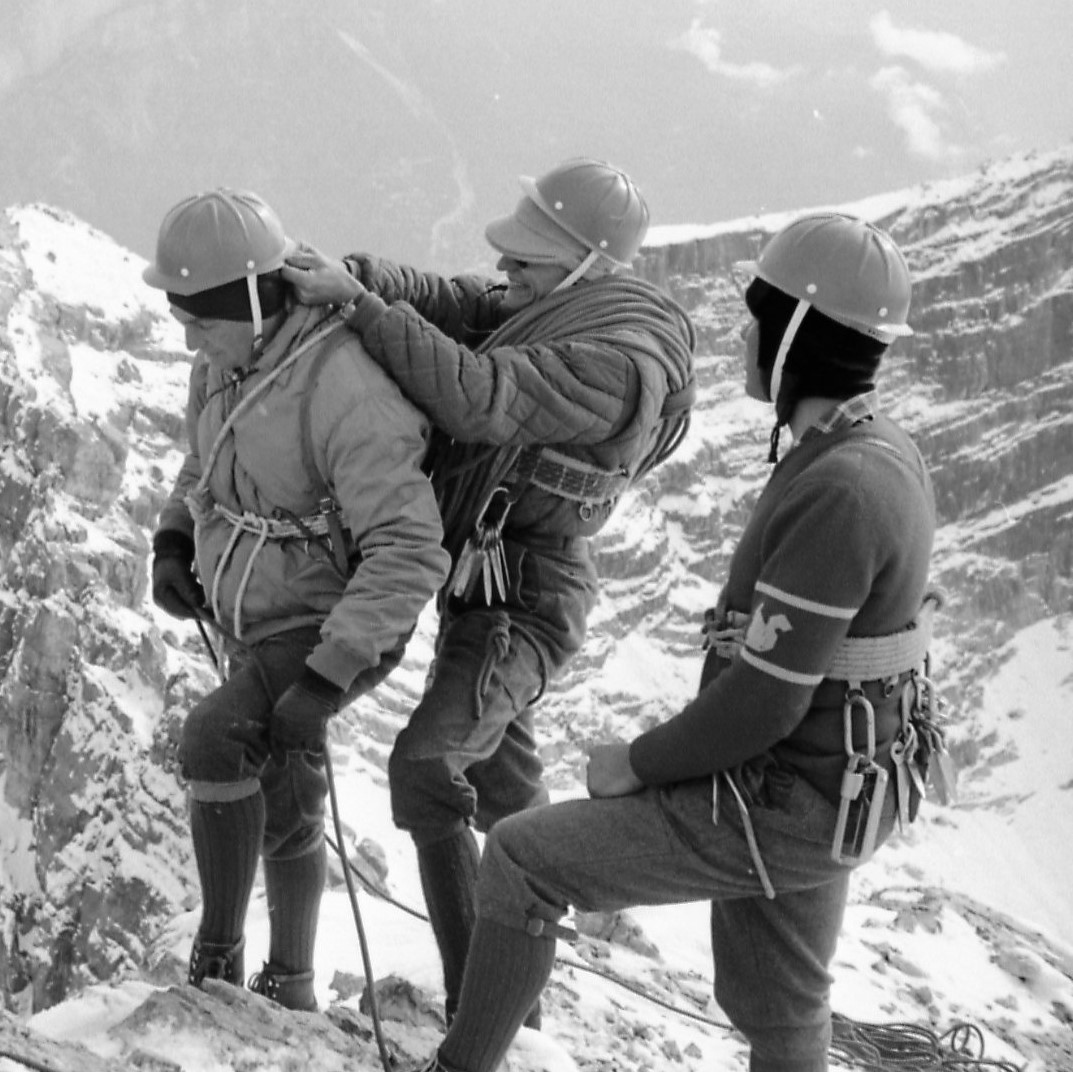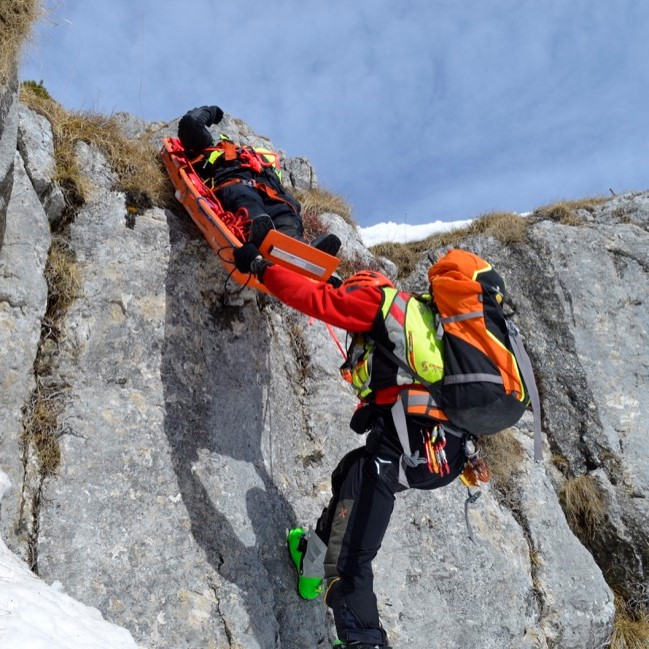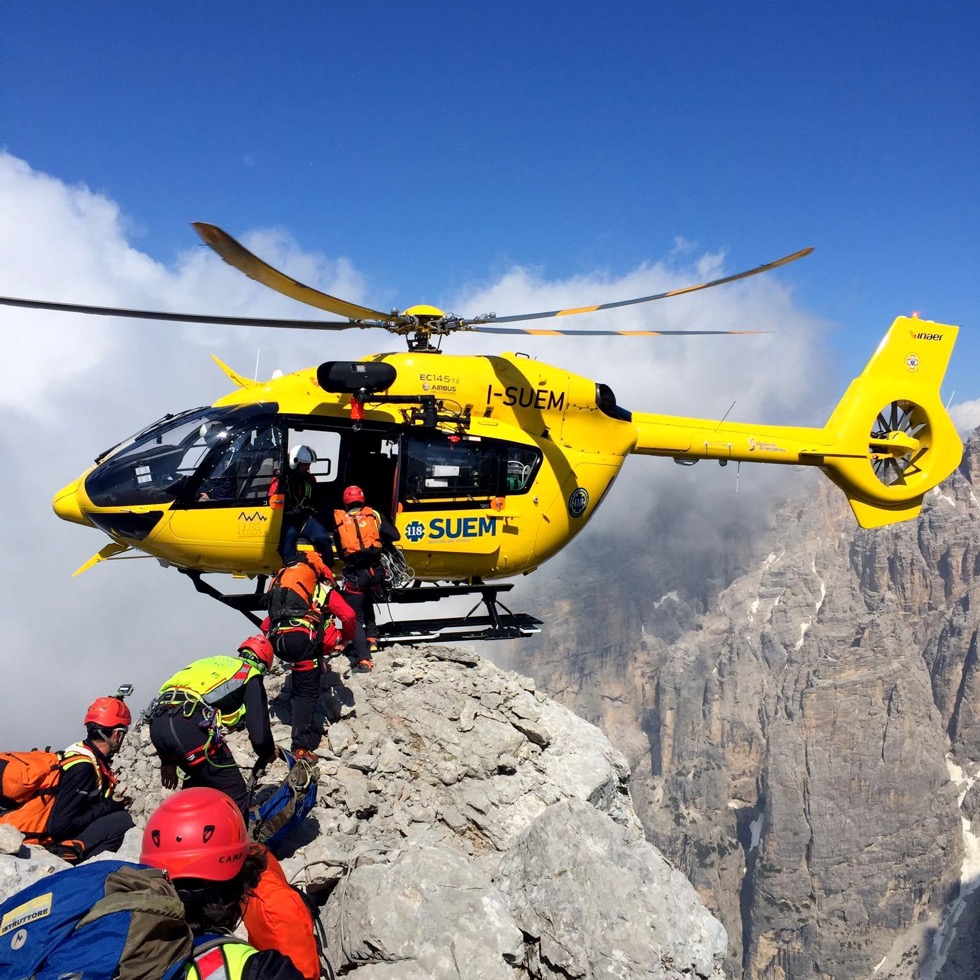The origins
Mountain rescue stems from the innate solidarity of people living in this habitat: mountain-dwellers have always provided help for travellers and people in difficulty.
In Cortina d’Ampezzo, the earliest mountain rescue activities were performed in the 1870s. When climbing developed, for mountain guides it became mandatory to provide assistance. In 1902 the Corpo Soccorso di Cortina (Cortina Rescue Service) was founded, headquartered at Hotel Croce Bianca, with call points (Meldestellen) located in the various mountain lodges and huts in the valley.
After the creation of the Scoiattoli Group, many operations performed both in Cortina and in nearby areas (Tre Cime, Pelmo, Civetta) were documented, and in 1969 the Cortina Mountain Rescue station, represented by the Scoiattoli Group, was awarded the gold medal for civil merit.
From “Il nonno racconta” (Grandfather’s tales) by Carlo Gandini.
From “Il nonno racconta” (Grandfather’s tales) by Carlo Gandini.
National Corps of Alpine and Cave Rescue
In more recent years, as visits to the mountains for tourism, sport or leisure became more frequent, the Mountain Rescue Service was given a more structured organisation, transforming what was a subsidiary section of the Italian Alpine Club (CAI, Club Alpino Italiano) into the National Corps of Alpine and Cave Rescue (CNSAS, Corpo Nazionale del Soccorso Alpino e Speleologico) in 1954, giving greater efficacy to the rescue work that for many years had already been performed by the people living in the mountains, both the Mountain Guides and the climbers of the Italian Alpine Club.
Mountain rescue activities were greatly assisted by the introduction of the helicopter, a vehicle that could transport the rescuers and rapidly recover victims and injured people. The first helicopter rescue in Cortina took place in 1964, when a Polish climber was recovered from Cima Ovest di Lavaredo (Lavaredo West Peak). In the 1970s and 1980s, the helicopter rescue service developed considerably and reached high standards of safety. In 1987 a unified health emergency centre – SUEM (Servizio di Urgenza ed Emergenza Medica, Urgent Medical and Emergency Service) – was created at the hospital of Pieve di Cadore, with the latest rescue equipment, including an Écureuil B2 helicopter. Initially, as the role of helicopter rescue technician did not yet exist, the task was assigned to Mountain Guides who were part of the Mountain Rescue Service.
From “Il nonno racconta” (Grandfather’s tales) by Carlo Gandini.
From “Il nonno racconta” (Grandfather’s tales) by Carlo Gandini.

In the Veneto region
In the Veneto region, Mountain and Cave Rescue Services are subdivided into three Delegations, II Dolomiti Bellunesi, XI Prealpi Venete, VI Speleologica, involving a total of 769 rescuers.
The SASV (Soccorso Alpino e Speleologico del Veneto, Veneto Alpine and Caving Rescue Service) receives requests for help in inaccessible mountains and cave locations, and it is available 24 hours a day, 365 days a year, across the whole region, and, on request from the CNSAS (National Corps of Alpine and Cave Rescue), for locations beyond its home region.
The II Delegazione Dolomiti Bellunesi operates in the provinces of Belluno and Treviso, comprising 504 rescuers. It is subdivided into 19 Stations: Agordo, Alleghe, Alpago, Auronzo, Belluno, Centro Cadore, Cortina d’Ampezzo, Feltre, Livinallongo, Longarone, Pedemontana del Grappa, Pieve di Cadore, Prealpi Trevigiane, San Vito di Cadore, Val Biois, Val Comelico, Val Fiorentina, Val Pettorina and Valle di Zoldo.
The II Delegazione Dolomiti Bellunesi operates in the provinces of Belluno and Treviso, comprising 504 rescuers. It is subdivided into 19 Stations: Agordo, Alleghe, Alpago, Auronzo, Belluno, Centro Cadore, Cortina d’Ampezzo, Feltre, Livinallongo, Longarone, Pedemontana del Grappa, Pieve di Cadore, Prealpi Trevigiane, San Vito di Cadore, Val Biois, Val Comelico, Val Fiorentina, Val Pettorina and Valle di Zoldo.
For further information on the organisation’s work, see the following link: https://www.cnsas.veneto.it/il-sasv/dati-2019

In Cortina d'Ampezzo
Cortina’s Mountain Rescue Station comprises 53 people, all Mountain Rescue Operatives, including Mountain Rescue Technicians, Mountain Guides, a doctor, a nurse, dog units and a Helicopter Rescue technician. On average, it performs between 90 and 120 operations every year.
Today, as a result of the speed at which it can intervene, the helicopter is widely used in rescue operations, when the location or the conditions of the injured person warrant its use, and it is feasible considering the weather and environmental conditions. Every operation is assessed by the respective SUEM headquarters for the area, which decides whether or not to despatch the air ambulance helicopter. The respective costs are determined by the health department of the Veneto Region in compliance with the tariffs applicable from 6th September 2011.
See the regional Tariffs for Rescue Services and Health Transportation (attachment B): https://bur.regione.veneto.it/BurvServices/pubblica/DettaglioDgr.aspx?id=234734

